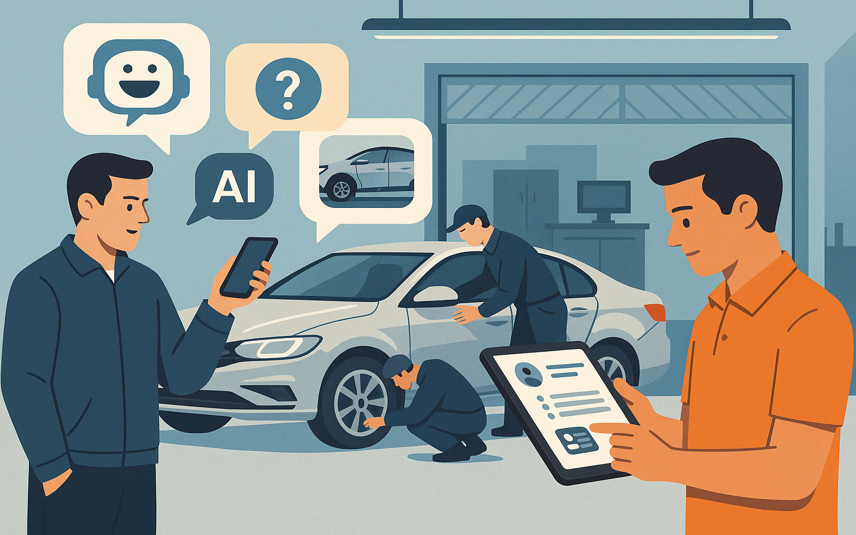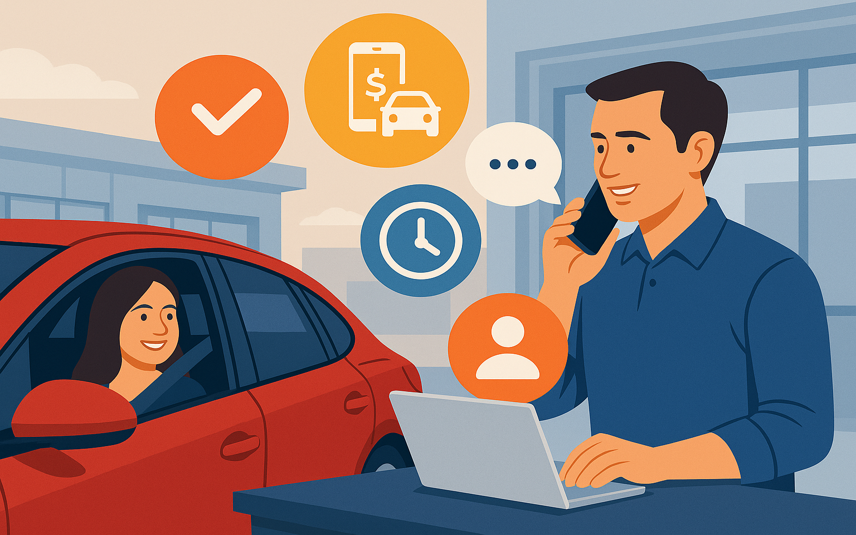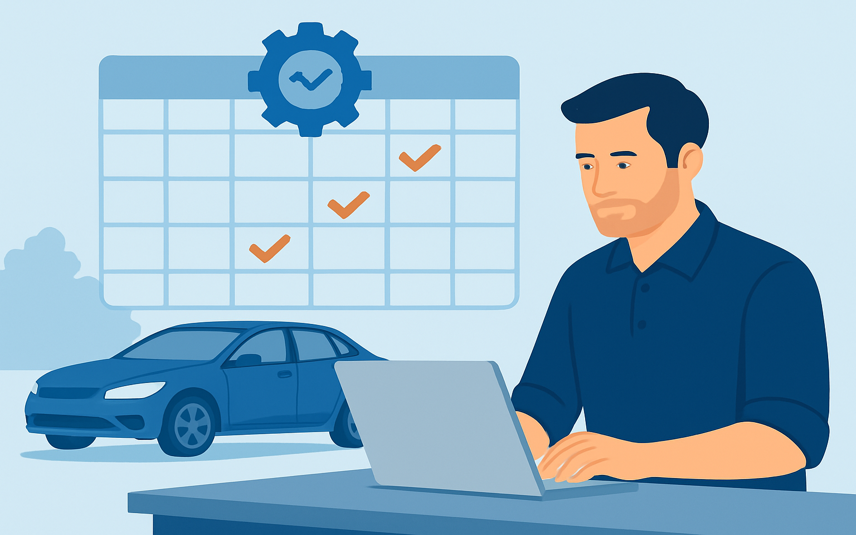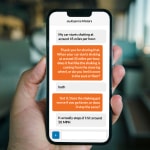6 Steps to Set Up a Service BDC For Any Size Dealership
Following these 6 easy steps will allow a dealership of any size to set up and benefit from the rewards a Service BDC can deliver.

Dealers differ in markets, philosophies, etc., but all have the same core values. There are six things that a dealership Service BDC needs to consider to be successful, and they can be applied by both small single franchise dealers as well as large dealer groups.
However, a clear understanding of the role of the BDC is essential because there are often different beliefs and perceptions about what a BDC does.
What is a Dealership Business Development Center (BDC)?
Traditionally, a BDC is a department within a dealership that generates leads and sets appointments for sales and service. They use many different methods, such as phone calls, emails, and texts, to reach potential customers.
A BDC’s main goals are to increase customer traffic at the dealership, improve customer retention, and increase sales and service revenue. Here is a general summary of what a BDC does:
- Schedules test drives or service appointments with potential customers
- Contacts past customers who have visited the dealership
- Emails or text message promotions to prospective customers
- Directs inbound customer inquiries to the appropriate department
- Analyzes customer data to identify opportunities
- Lease retention activities
- Client satisfaction / CSI survey requests and collection
- Outreach to the community and cross–promotional marketing
By generating leads and setting appointments, the BDC helps ensure that sales and service teams have a steady stream of customers.
Timely responses to customer inquiries and providing helpful information allow the BDC to build trust and establish long–term relationships with customers.
However, the staffing, management, and organizational infrastructure to support a BDC can be daunting and prohibitive for some dealerships. It is especially difficult for smaller single franchise owners. This is why focusing on just a Service BDC may be a more practical and effective starting point.
A Service BDC Focus
A dealership’s Service BDC can handle inbound and outbound appointment-setting duties that a BDC manager and customer service representatives or agents typically staff.
In a world where 66% of service advisors fail to ask customers for appointments, what would it mean for your dealership to convert those callers into appointments?
Having a Service BDC can give your customers a more personal experience. Service BDC Agents are more likely to develop relationships with customers and build trust over time because they are focused on providing an excellent customer experience from start to finish.
Keeping customers informed about service appointments is one of the most important functions of a BDC. This ensures that your customers are seen promptly, and your staff can provide the best possible service.
Is it better to answer the phone with a rushed, distracted tone, not be able to answer the caller’s questions, or worse, not answer at all, so the caller is looped in an endless ring cycle – or sent to voicemail?
The caller will likely not try again if they don’t get an answer on their first attempt. Research shows that 76% of consumers form a judgment of a dealership based solely on their initial call.
Since 2008, the number of customers leaving messages has also been dropping by 8-10% every year; hence, a lack of knowledge or a busy person answering calls can have damaging effects on the service department’s reputation – and voicemails might as well be considered lost leads.
This is why it is crucial to consider these 6 steps for setting up a successful service BDC:
- Set Objectives
- Staff Appropriately
- Schedule Effectively
- Consider Technology Partners
- Go Omnichannel
- Invest in Training
#1 Set Objectives
A Service BDC usually must accomplish the following, but this can be modified to fit the objectives of your particular dealership. The key is to simply have objectives in the first place. Here are some obvious ones:
- Scheduling service
- Contact past service customers to recommend/remind them about upcoming service needs, or past declined services
- CSI (Customer Service Improvement and survey collection)
- Service to Sales (convert people who service to new car buyers)
- Vehicle Acquisition – buyout positive equity servicers to fuel used car inventory
Remember pay plans, reporting, accountability, training, goals/projects, and finally, your ROI when setting these objectives. A Dealer principal, GM, and BDC Director should all have a seat at the strategy and decision-making table. BDC Agents are just as important as the showroom sales team.
#2 Staff Appropriately
Many dealerships still rely on old staffing practices – when business was conducted in the showroom, but now the new showroom is the internet and phones. As a result, the typical Service BDC does not have enough staff to be effective. Automotive stats vary, but it is safe to allow for each Service BDC Agent to handle a mix of 70 inbound calls and 160 outbound calls per day. So make sure you have enough staff to handle your current service volume properly and plan for growth.
You also want to be sure you have the right people, both as BDC Agents and as Directors and Managers. To find the right people, you must ensure you can attract them. They need to be highly-trained or experienced people who can handle complex customer inquiries and use sophisticated scheduling systems.
You get what you pay for. If you don’t have the necessary pay plan for a real manager, you will end up with subpar management and matching results. The same goes for every BDC role.
#3 Schedule Effectively
Scheduling effectively is important. A slight adjustment in available BDC Agent times can deliver up to a 20% increase in connections and set appointments. However, this will vary from dealer to dealer. In some cases, we have heard that the best time for maximum prospect connections is between 6 and 8 p.m. – but this time slot applies more for a sales BDC.
Consider lightening your Service BDC staff on Saturdays – when it’s not as necessary, schedule just enough staff for weekends to handle the demand. You will make more appointments during the weekdays, so staff accordingly for maximum return.
Consider texting as the primary channel for setting and confirming appointments. This can further enhance your scheduling efficiency, as texts tend to get a faster and higher level of response for appointment setting.
Your connection ratios, conversion ratios, and conversion rates will drop if you’re not using the right channels and staffed appropriately.
Sometimes just minor tweaks to the schedules of BDC Agents and Managers can increase engagement and conversion. We recommend testing what works best for your dealership and BDC type.
#4 Consider Technology Partners
The Internet and phones are the ‘new’ showrooms, with most consumers starting their dealership engagement in these channels. Since COVID phone calls have been on the rise, why wouldn’t you devote your best efforts to solutions that can help you in these channels?
Also, consider omnichannel communications platforms that allow consumers easy access to their auto dealership service department. Ideally, find one solution that allows you to offer customers the ability to call, text, or email. Even better if the solution has APIs that will allow for easy integration with your CRM.
Keeping customers informed about service appointments is one of the most important functions of a BDC. This ensures that your customers are seen promptly and that your staff can provide the best possible service.
Solutions that offer one dashboard to manage all customer service communications help BDC Agents and Service Advisors see every customer communication thread in one place, in real-time.
Find Solutions that enable easy response text and email templates to save time, and prevent your BDC Agents from having to write the same message multiple times a day. Ideally, templates can be set up by your dealership for customization that is in line with your internal processes.
Scheduling tools can also help you keep track of appointments and make sure that they are always scheduled promptly. This will save you time and ensure that customers are seen as soon as possible. Scheduler features to look for include:
- Ability to auto-populate customer information
- Calendar view appointments to see incoming customers and open appointment times
- Customer service history, including past declined services
- integration APIs for customer transportation options, recall data, and tire spec information
No-shows happen, but it’s important to keep track of them so that you can prevent them in the future.
Find solutions that include color coding or reporting to track no-shows, so you can identify patterns and adapt your appointment scheduling process accordingly.
#5 Go Omnichannel
BDC shared inboxes face new challenges with the need for omnichannel communications. With the advent of text and email, you now have more to deal with in addition to single-channel voice calls.
A universal shared inbox solution that can handle all three channels of communications (text, emails, and voice calls) as one conversation type and seamlessly and intelligently transfer messages to the BDC Agents as one conversation is critical.
A Universal Inbox allows your customers a single place to communicate with you. It provides an integrated view of all customer communications, regardless of the channel used, and enables your BDC team to respond quickly to customers and reduce time-wasting status calls.
With a Universal Inbox, you can:
- Respond quickly to customers: With all customer communication in one place, you can ensure that inquiries are answered promptly.
- Increase customer satisfaction: By providing a single point of contact for your customers, you can make it easy for them to get the information they need and resolve any issues.
- Improve efficiency: With all communication channels in one place, your team can quickly triage and route inquiries to the appropriate person or department.
#6 Invest in Training
Invest in training. NADA estimates the average dealer spends about $64,000 monthly on advertising, close to $640 per car sold. However, dealers are spending less than $1,000 per month on training for the entire dealership (sales consultants, BDC reps, and management).
Develop your people through training, professional development, personal development, and team building to retain and grow the bottom line.





